Dynamic Response and Failure Mechanism of Deep-Buried Tunnel with Small Net Distance under Blasting Load
Abstract
:1. Introduction
2. Methodology
- (1)
- Linear regression analysis
- (2)
- Nonlinear regression analysis [18]
3. Experiment Study
3.1. Project Summary
3.2. Experimental Scheme
3.2.1. Design of Blasting Parameters for the Standard Section of Three Holes Separation
3.2.2. Vibration Monitoring Scheme
3.3. Monitoring Results and Analysis of Blasting Vibration
3.3.1. Vibration Monitoring Results
3.3.2. Analysis of Measured Data
4. Numerical Simulation of Dynamic Response of Lining
4.1. Parameter Selection
4.2. Simulated Result
4.2.1. Analysis of Tunnel Force under the Influence of Dead Weight
- (1)
- As can be seen Figure 12, Figure 13 and Figure 14, in the X and Z directions, the tunnel is mainly affected by the stress released by the surrounding rock mass due to excavation, and there is no large stress concentration around the tunnel in the X direction. In the Z direction, there is a certain stress concentration in the vault and the hance. In the Y direction, i.e., the direction of the dead weight of rock mass, the stress concentration is greater at the vault and above, while the stress is smaller at the arch foot and tunnel bottom.
- (2)
- In Figure 15, under the action of X, Y and Z directions, the stress concentration is the largest at the hance, followed by the vault and the arch foot. The surrounding rock within a certain range will produce a certain stress.
- (3)
- As can be seen from Figure 16, the rock mass around the tunnel does not produce displacement under the action of rock mass gravity. This is because the tunnel is deep underground and gravity cancels out under the action of ground stress and surrounding rock stress.
4.2.2. Vibration Velocity Analysis of the Left Tunnel Lining of a Deep-Buried Tunnel with Small Interval
- (1)
- Analysis of vibration velocity distribution on inner lining
- (1)
- As shown in Figure 17a, on the inside of the lining, the blasting vibration velocity first occurs at the arch foot, and its vibration velocity is also small, about 7.52 cm/s;
- (2)
- As can be seen from Figure 17b, the vibration velocity at the arch foot increases to 15.25 cm/s in a very short time and extends to the tunnel hance. It can be found in Figure 17c that the peak vibration velocity at the hance reaches 23.25 cm/s, and the vibration velocity spreads in the upper part and the bottom part.
- (3)
- As can be seen from Figure 17d, the vibration velocity continues to spread along the tunnel lining towards the vault and tunnel bottom.
- (2)
- Analysis of vibration velocity distribution on external lining
- (1)
- At the initial stage of blasting load, the lining of the blasting side of the existing left tunnel is affected by vibration first, and a vibration velocity circle is formed. The vibration velocity of the vibration velocity circle is relatively small, and the scope of action is not large, as shown in Figure 18a,b. The vibration velocity of the arch foot in the vibration velocity circle is the largest.
- (2)
- When the blasting load continues to increase, the vibration velocity circle increases rapidly and so does the vibration velocity, but it does not reach the maximum value, as shown in Figure 18c.
- (3)
- With the increase in time, the blasting stress wave continues to propagate and reflect in the medium, and reaches a maximum value of 30.55 cm/s in Figure 18d. At this time, the blasting load has been unloaded and then vibrates. The peak value of dynamic velocity decreases gradually until it approaches 0.
- (3)
- Analysis of transverse vibration velocity distribution
- (1)
- The vibration velocity is the largest at the arch foot of the blasting side lining of the existing tunnel. The velocity of hance is slightly smaller than that of arch foot but larger than that of vault. As section 0 is very close to the detonation source, the vibration speed reaches 30.55 cm/s, but it rapidly decreases to 6.55 cm/s at section 23, as shown in Figure 19.
- (2)
- Section 0 first reaches the peak value of blasting vibration velocity, and its blasting vibration velocity rapidly decreases after reaching the maximum value. The blasting vibration wave attenuates the fastest. Section 5 is the second, and its blasting vibration attenuation rate is less than that of section 0. The attenuation velocity of section 13 is obviously less than that of sections 0 and 5 after it reaches the peak velocity of blasting vibration. The blasting vibration velocity of section 23 reaches the peak time the latest, and the attenuation speed is also the smallest.
- (4)
- Analysis of longitudinal vibration velocity distribution
- (1)
- The blasting vibration velocity of section 0 and section 5 (i.e., near the blast source) attenuates the fastest after reaching the peak. However, the attenuation rate of the vibration velocity of section 13 and section 23 is significantly lower than that of the former, and their attenuation velocity is roughly the same.
- (2)
- In the longitudinal direction of the existing tunnel (i.e., in the directions of measuring points 2, 3, 4 and 5), the vibration velocity of the blasting lining of the existing tunnel decreases gradually. This indicates that the vibration velocity of the measuring point decreases rapidly with the increase of the distance to the blasting source.
- (3)
- With the increase in the detonation source distance, the moment when different sections reach the peak vibration velocity is different. The moment when the measuring points of section 0 and section 5 reach the peak vibration velocity is almost the same, while 13 and 23 reach the peak vibration velocity later. This indicates that the surrounding rock vibration frequencies are similar in the area of section 0 to section 5. The vibration velocity at the arch foot of sections 13 and 23 is 0 in 0–2 ms.
4.3. Analysis of Displacement of Left Tunnel
4.4. Acceleration Analysis of Measured Points
5. Conclusions
- Through the spectrum analysis of the field measured waveform and the nonlinear regression of the data, the empirical formula conforming to the attenuation law of the Sadowski vibration velocity of the project is obtained.
- On the inside of the lining (the side contacting the tunnel headroom), the vibration continues from the arch foot along the tunnel lining towards the vault and tunnel bottom. On the outside of the lining (the side contacting the surrounding rock), the lining on the blasting side is affected by vibration before the back side at the initial stage of blasting. The vibration velocity in the order of large to small is arch foot, tunnel hance, and vault.
- After the blasting action is completed, the vibration velocity of the lining structure gradually decreases but will not disappear, and will only approach 0. The vibration velocity of the cross-section shows little change. The vibration velocity of the section near the detonation source attenuates faster, while the vibration velocity of the section far away from the detonation source attenuates slower and there is little difference in the attenuation velocity.
- The influence of the horizontal displacement of the tunnel lining is greater than that of the vertical displacement, and the randomness of the vertical displacement is larger. The influence of the inner displacement of the lining is greater than that of the outer displacement.
- The vibration acceleration at the arch foot of the section is the largest, followed by that at the tunnel hance, and the peak value of vibration acceleration at the vault is the smallest.
Author Contributions
Funding
Data Availability Statement
Conflicts of Interest
References
- Xia, M. Influence factors on stability of Surrounding rock of tunnel with small clear spacing. J. Civ. Env. Eng. 2021, 43, 73–80. [Google Scholar]
- Li, R.; Wang, S.T.; Zhang, D.L.; Chen, P.; Pan, H.A.; Li, A. Control mechanism and engineering application of pillar-reinforcing bolt in closely spaced tunnels. Rock Soil Mech. 2022, 7, 1865–1876. [Google Scholar]
- Xiong, L.; Zhou, C.; Jiang, N.; Wang, T.; Meng, X. Dynamic Response and Safety Control of Newly Poured Secondary Lining Concrete under Large Section Tunnel Blasting-A Case Study of Longnan Tunnel of Ganshen High-speed Railway. Period. Polytech. Stroit. 2022, 66, 1294–1308. [Google Scholar] [CrossRef]
- Li, X.J.; Yang, Z.X.; Huang, F.; Wang, C.P.; Liu, X.Z. Actual measurement and simulation study on Mechanical Characteristics of shallow tunnel support with large section and small clear distance. Sci. Technol. Ind. 2022, 22, 309–314. [Google Scholar]
- Pan, W.T.; He, C.; Wu, F.Y.; Xu, Y.J.; Yao, R.J.; Yan, Q.X. Study on Bonding Construction and Blasting Vibration Effect of Small clean Distance Three-hole parallel Railway Tunnel. Railw. Std. Des. 2022, 12, 1–10. [Google Scholar]
- Wu, T.; Zhou, C.B.; Jiang, N.; Xia, Y.Q.; Bin, Z. Study on the Mechanical Cumulative Damage Model of Slope Fault Fracture Zone under the Cumulative Effect of Blasting Vibration. Period. Polytech. Civ. Eng. 2020, 64, 845–858. [Google Scholar] [CrossRef]
- Zhu, Z.G.; Fang, Z.C.; Han, Z.M.; Ding, X.; Ma, C.Y.; Sun, M.L.; Wang, Z.W. Research on Classification Standard and Control Technology of Extrusion Large Deformation of Deep Buried Tunnel. J. Railw. Eng. Soc. 2022, 39, 47–52. [Google Scholar]
- An, Y.L.; Tan, G.Y.; Li, J.H.; Zhu, T.H.; Guo, J.D.; Yue, J. Study on surrounding rock pressure of Deep tunnel with small clear distance under nonlinear failure criterion. J. Catas. 2022, 12, 1–10. [Google Scholar]
- Wang, Y.Q.; Gong, L.J.; An, N.N.; Peng, X.B.; Wang, W.; Wang, Z.F. Field Investigation of Blasting-Induced Vibration in Concrete Linings during Expansion of Old Highway Tunnel. Adv. Civ. Eng. 2021, 2021, 8820544. [Google Scholar] [CrossRef]
- Wu, K.H.; Shi, E.L.; Yu, H.Z.; Gong, W.J. Pressure analysis of surrounding rock of asymmetric three-hole tunnel with small clear distance. Chin. J. Undergr. Space Eng. 2022, 18, 65–73. [Google Scholar]
- Zhu, D.P.; Abrae, T.; Xu, H.B. Dynamic response prediction of rock pile under blasting vibration in DaqianShiling Tunnel. Chin. J. Undergr. Space Eng. 2021, 17, 645–649. [Google Scholar]
- Hao, R.J. Dynamic response analysis of tunnel with small clear distance under blasting load. Water Resour. Hydropower Eng. 2020, 51, 291–297. [Google Scholar]
- Ma, J.J.; Li, C.H.; Guan, J.W.; Chen, W.X.; Huang, L.C. Dynamic response of close-range explosion over a subway tunnel. J. Railw. Sci. Eng. 2022, 12, 1–10. [Google Scholar]
- Ma, Y.Y.; He, H.H.; Zhang, Y.; Tie, J.K.; Liu, G.F.; Jiang, W.; Gao, Q.D. Analysis of Blasting Vibration Response Characteristics and Safety Control of first tunnel with Small Clear distance Large Section. Blasting 2022, 12. [Google Scholar]
- Li, X.G.; Zhou, X.Q.; Yang, H.P.; Fu, X.Q.; Yu, J. Vibration control and Damage identification of Rock Burst in tunnel with Large span and Small clear Distance. Tunnel Constr. 2022, 42, 406–413. [Google Scholar]
- Ji, L.; Zhou, C.B.; Zhang, B.; Wang, F.X. Study on dynamic response and damage effect of surrounding rock in large tunnel under blasting excavation. J. China Railw. Soc. 2021, 43, 161–168. [Google Scholar]
- Yan, Y.P. Study on stress-strain characteristics and dynamic response of double tunnel excavation in soft rock area. Railw. Constr. Technol. 2022, 7, 106–110. [Google Scholar]
- Wang, Z.H.; Wang, Q. Nonlinear regression method with zero residual sum of residual errors and its application. J. Northeast For. Univ. 2011, 39, 125–127+130. [Google Scholar] [CrossRef]
- Alipour, A.; Mokhtarian-Asl, M.; Asadizadeh, M. Support Vector Machines for the Estimation of Specific Charge in Tunnel Blasting. Period. Polytech. Civ. Eng. 2021, 65, 967–976. [Google Scholar] [CrossRef]
- He, Y.C.; Chen, Q.N.; Yi, L.W.; Huang, X.T.; Zeng, A.; Zhou, M.Y.; Zhou, G.Y. Influence of tunnel blasting vibration on secondary lining of new ultra short age concrete. J. Cent. South Univ. (Sci. Technol.) 2020, 51, 507–513. [Google Scholar]
- Li, C.X.; Yang, R.S.; Wang, Y.B.; Xu, B.; Zuo, J.J.; Xie, P. Research on deep hole segmented charge cut blasting of rock roadway based on numerical simulation. J. Coal Sci. Technol. 2022, 9, 1–18. [Google Scholar]
- Xie, L.X.; Lu, W.B.; Jiang, Q.H.; Zhang, Q.B.; Wang, G.H.; Chen, M.; Yan, P. Damage evolution mechanism of deep rock mass in process of cut blasting. J. Cent. South Univ. (Sci. Technol.) 2017, 48, 1252–1260. [Google Scholar]
- Xie, Q.M.; Jia, Y.S.; Ding, K.; Zhang, J.; Ling, Z.D.; Liu, D.S. Chaotic characteristics analysis of tunnel blasting vibration signals. J. Vib. Shock 2022, 41, 238–244+306. [Google Scholar] [CrossRef]
- Wang, H.L.; Li, S.; Zhao, Y. Research on blasting damage law of initial concrete support under cumulative effect. Eng. Blasting 2021, 27, 29–33+50. [Google Scholar] [CrossRef]
- Yin, H.; Ouyang, Y. Experimental and Numerical Study on Steel Fiber Concrete under Blast Loading. Buildings 2022, 12, 2119. [Google Scholar] [CrossRef]
- Liu, J.; Liu, C.; Qu, K.; Li, J.; Wu, C. Calibration of Holmquist Johnson Cook (HJC) model for projectile penetration of geopolymer-based ultra-high performance concrete (G-UHPC). Structures 2022, 43, 149–163. [Google Scholar] [CrossRef]
- Wang, C.; Song, R.; Wang, G.; Zhang, S.; Cao, X.; Wei, P. Modifications of the HJC (Holmquist–Johnson–Cook) Model for an Improved Numerical Simulation of Roller Compacted Concrete (RCC) Structures Subjected to Impact Loadings. Materials 2020, 13, 1361. [Google Scholar] [CrossRef] [Green Version]
- Yong, W.; Wu, Y.; Dai, Y.C.; Wang, S.S.; Wu, B.; Xu, S.X.; Wei, H. Analysis of Mutual Influence on Blasting Construction of Urban Shallow-buried Small Spacing Tunnels. Earth Environ. Sci. 2020, 525, 012055. [Google Scholar] [CrossRef]
- Li, X.H.; Liang, C.; Xu, X.L. The Research of Influence of Above Building on Tunnel Dynamic Response. Mater. Sci. Eng. 2018, 39, 329–336. [Google Scholar] [CrossRef]
- Kirzhner, F.; Rosenhouse, G. Numerical analysis of tunnel dynamic response to earth motions. Tunn. Undergr. Space Technol. 2020, 15, 249–258. [Google Scholar] [CrossRef]
- Xu, J.F.; Wang, J.C.; Bian, C.; He, P. Analysis of foundation pit excavation’s influence towards adjacent tunnel under soft soil geological conditions in Hangzhou. Bull. Sci. Technol. 2020, 36, 103–108. [Google Scholar]
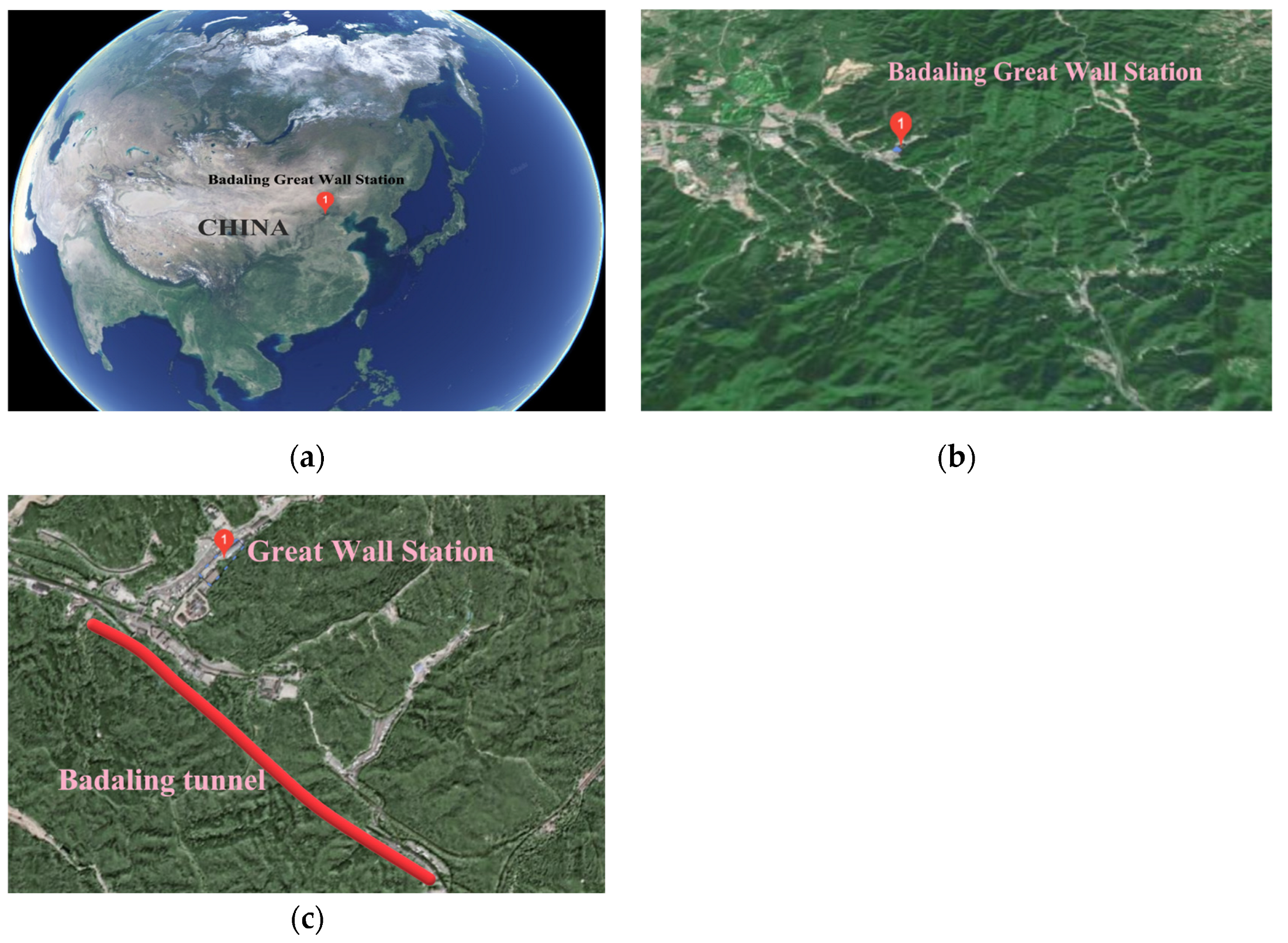


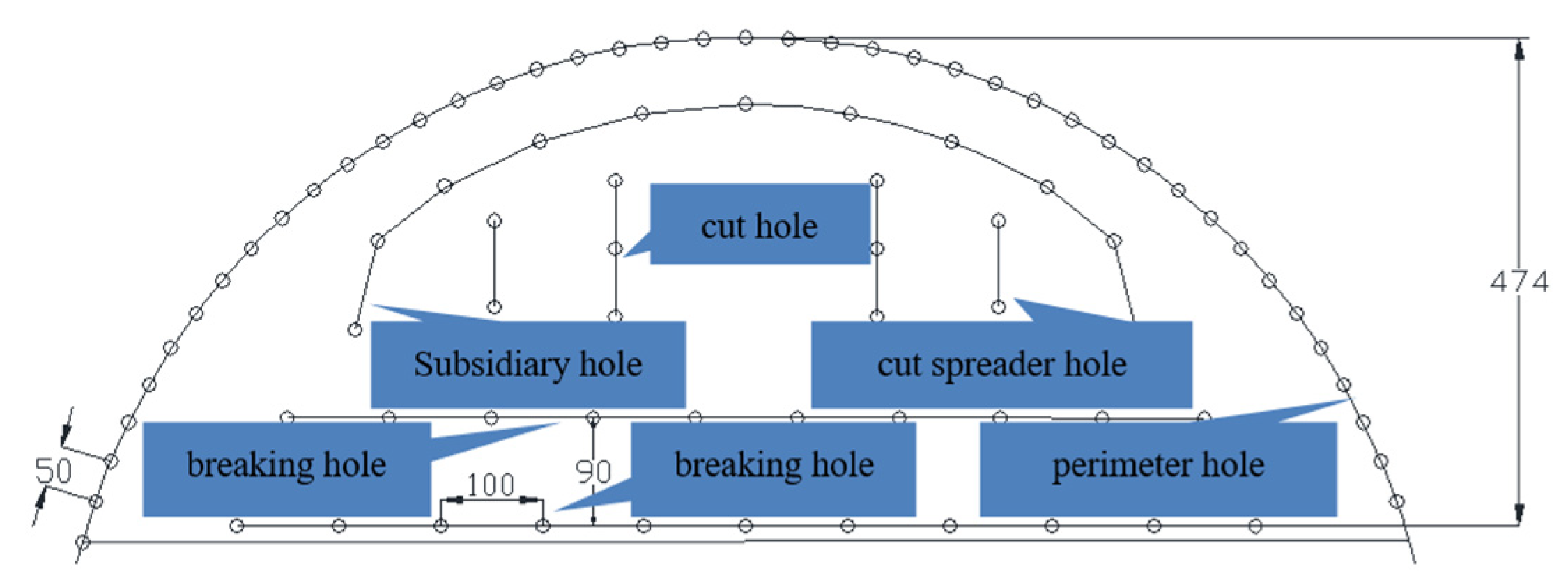
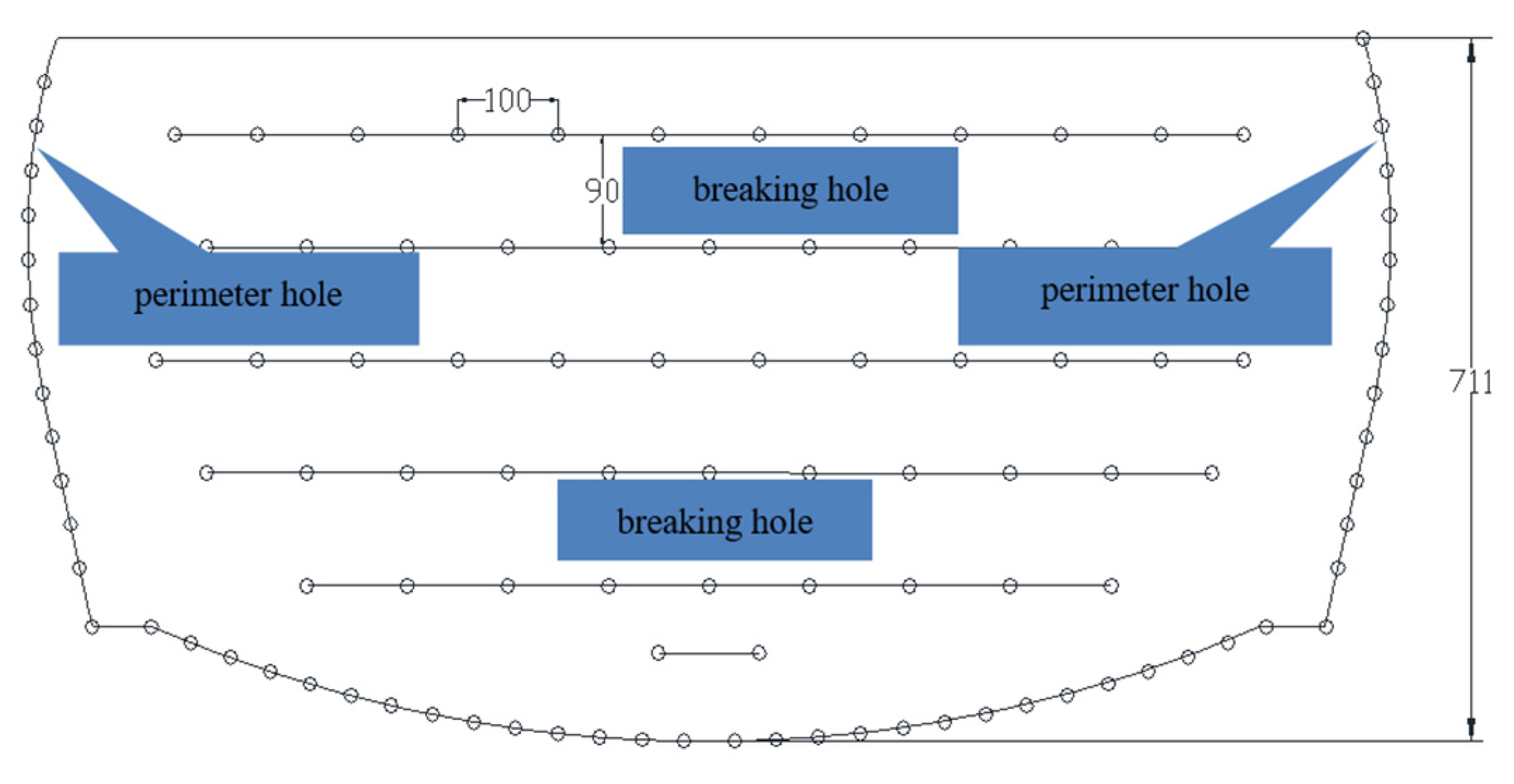
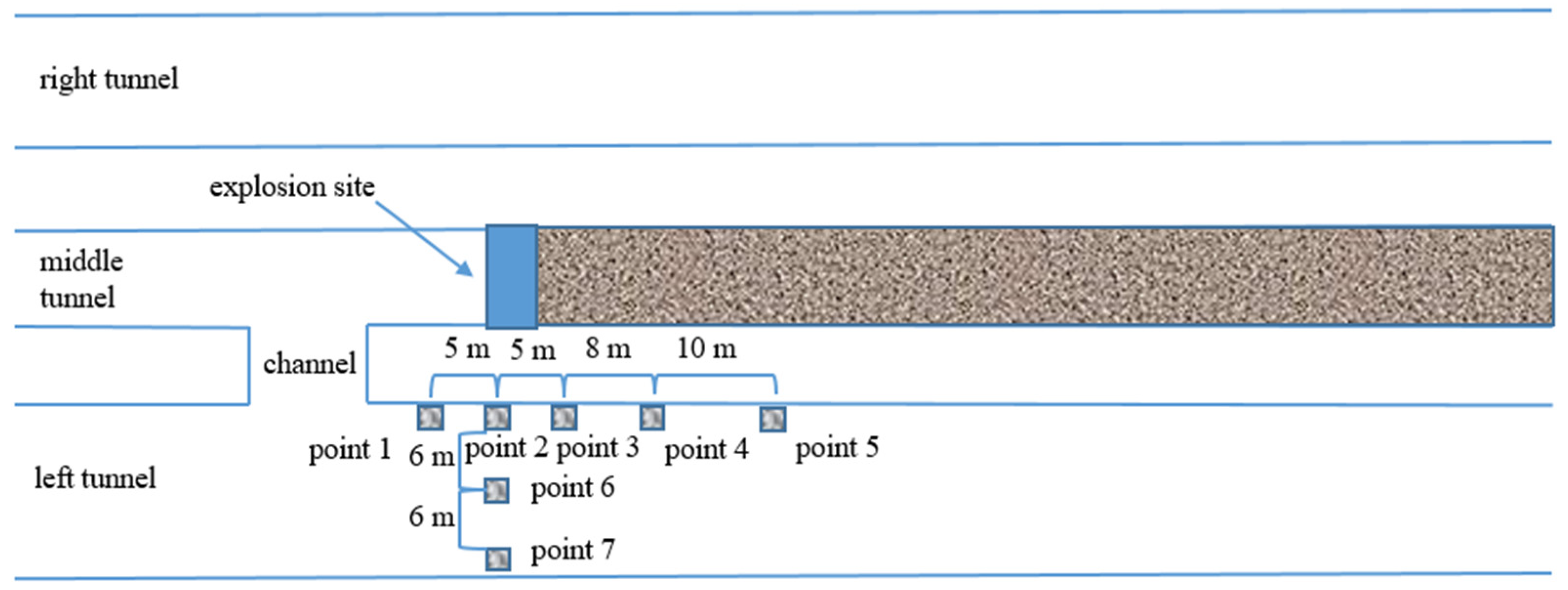
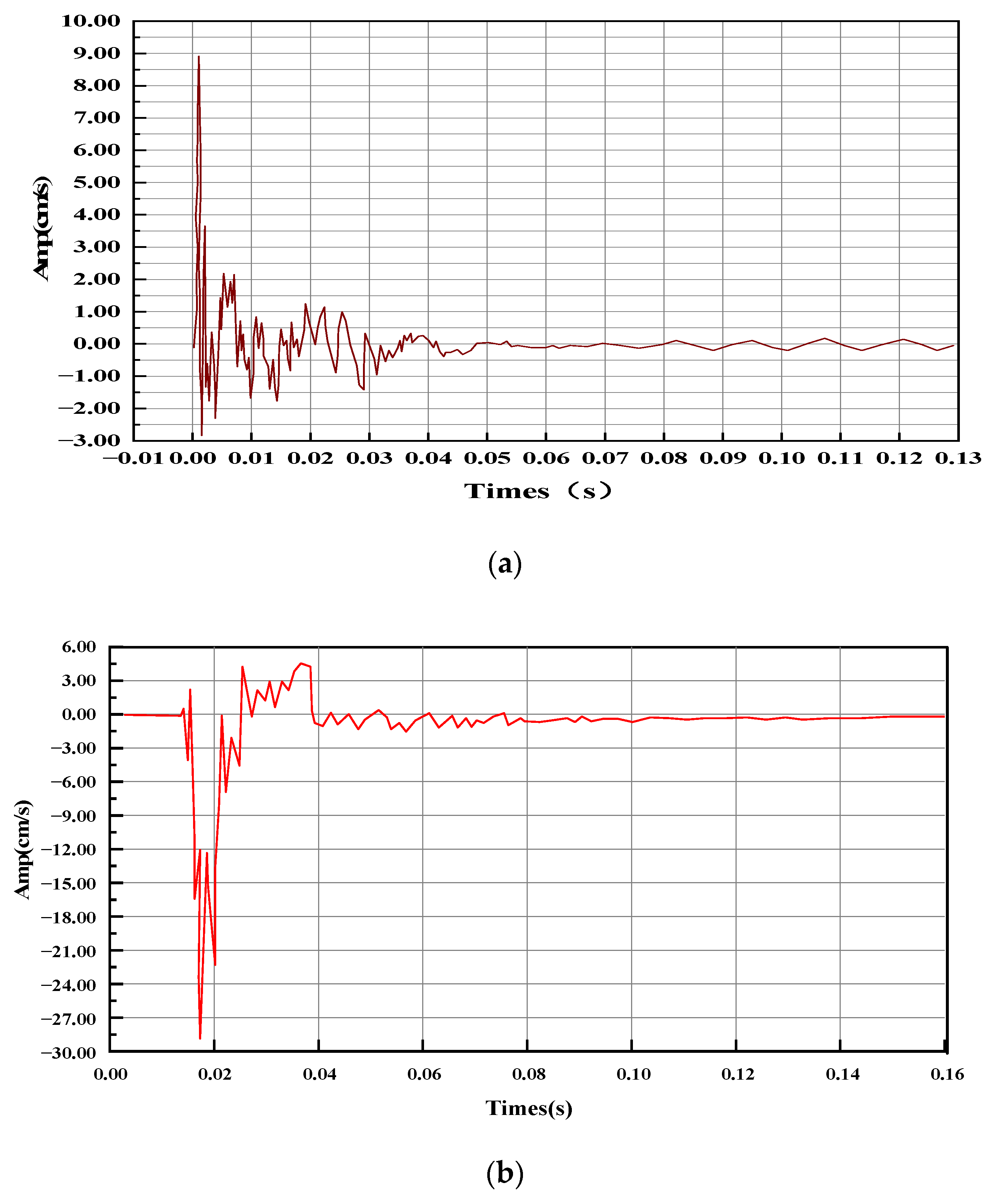

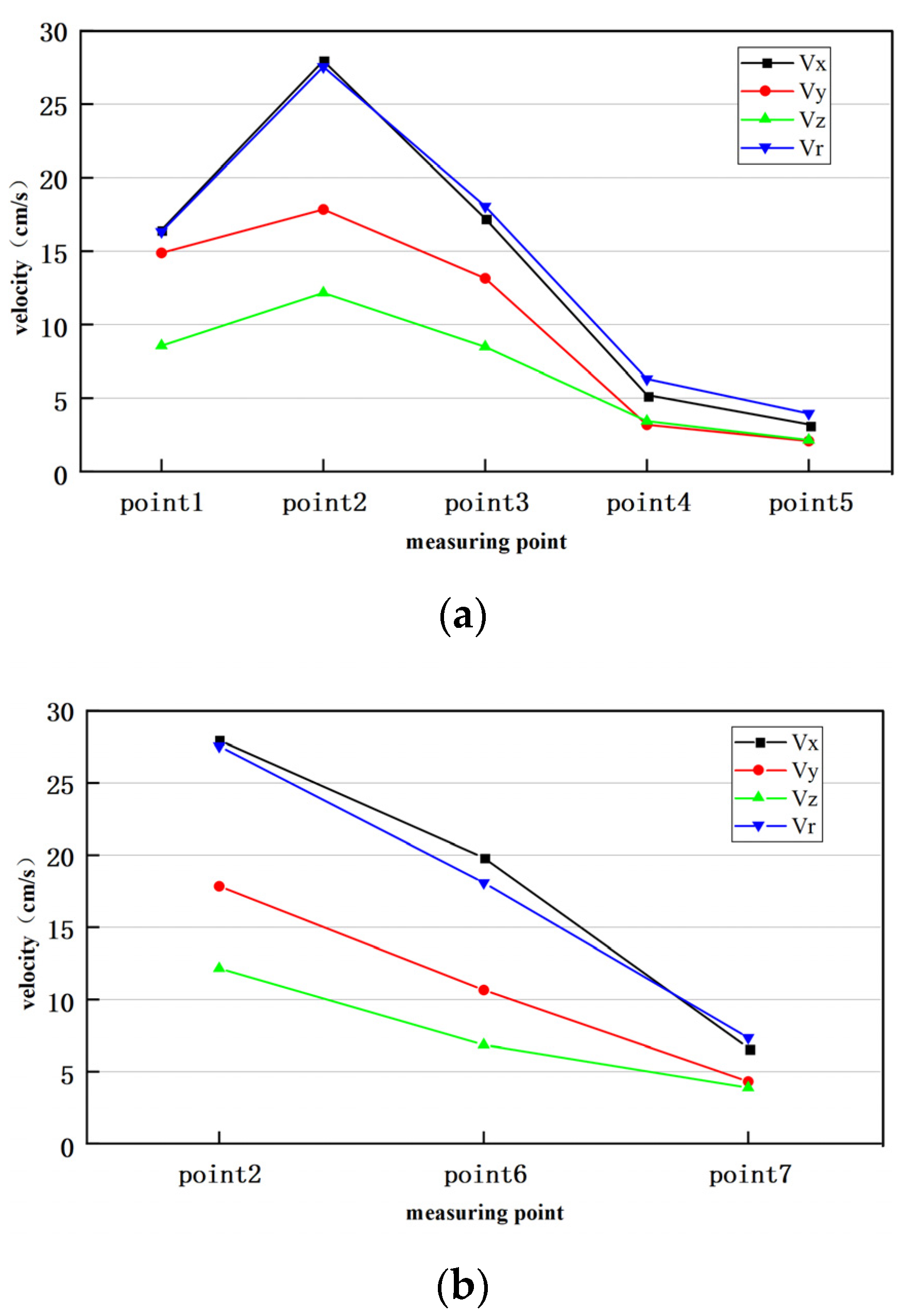
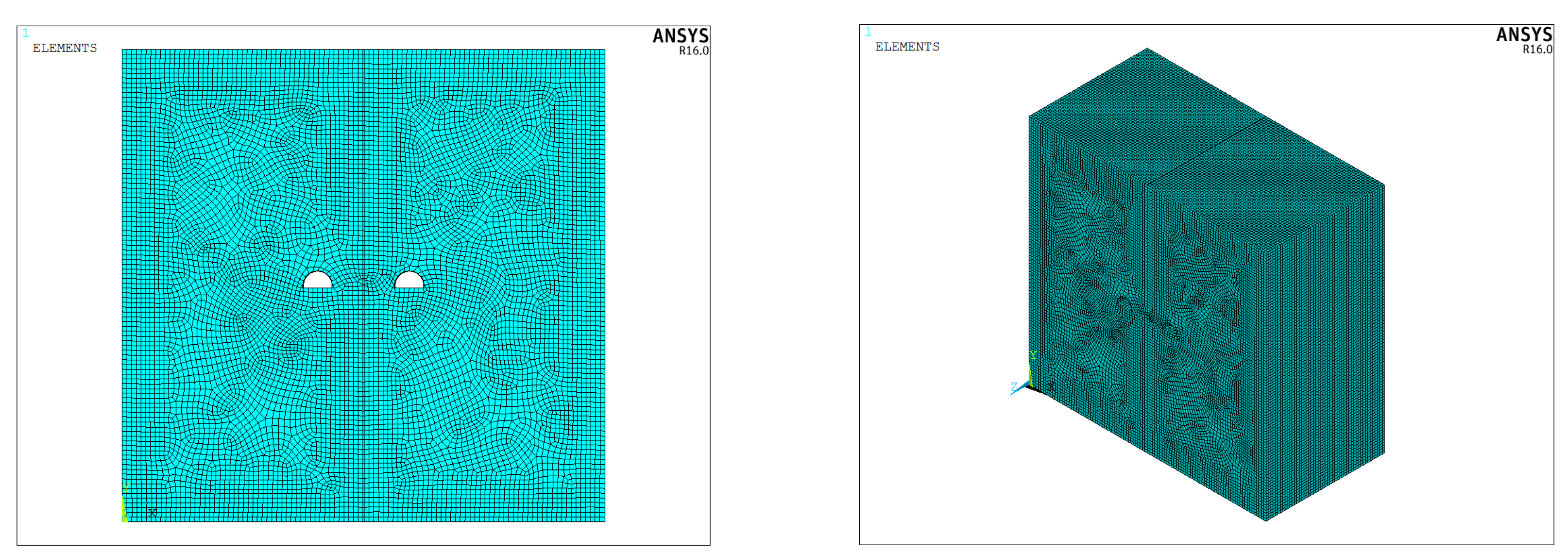

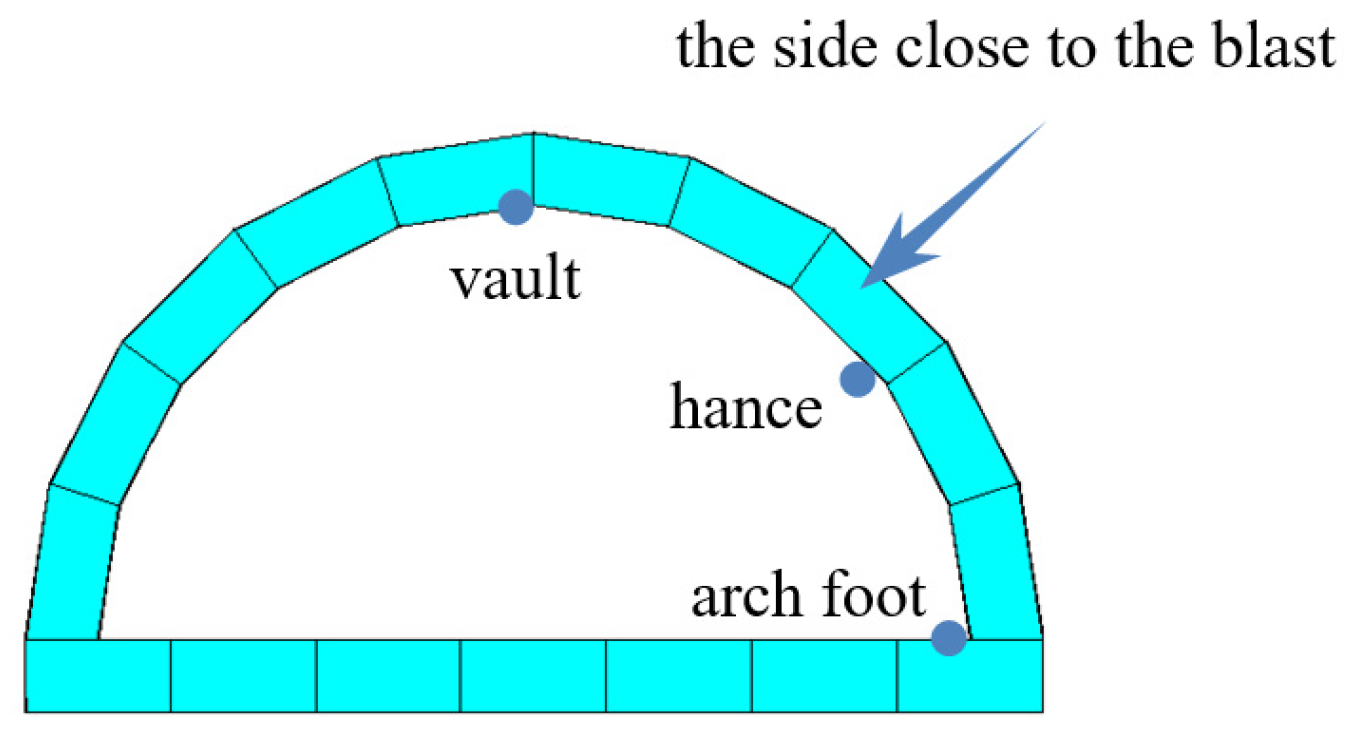
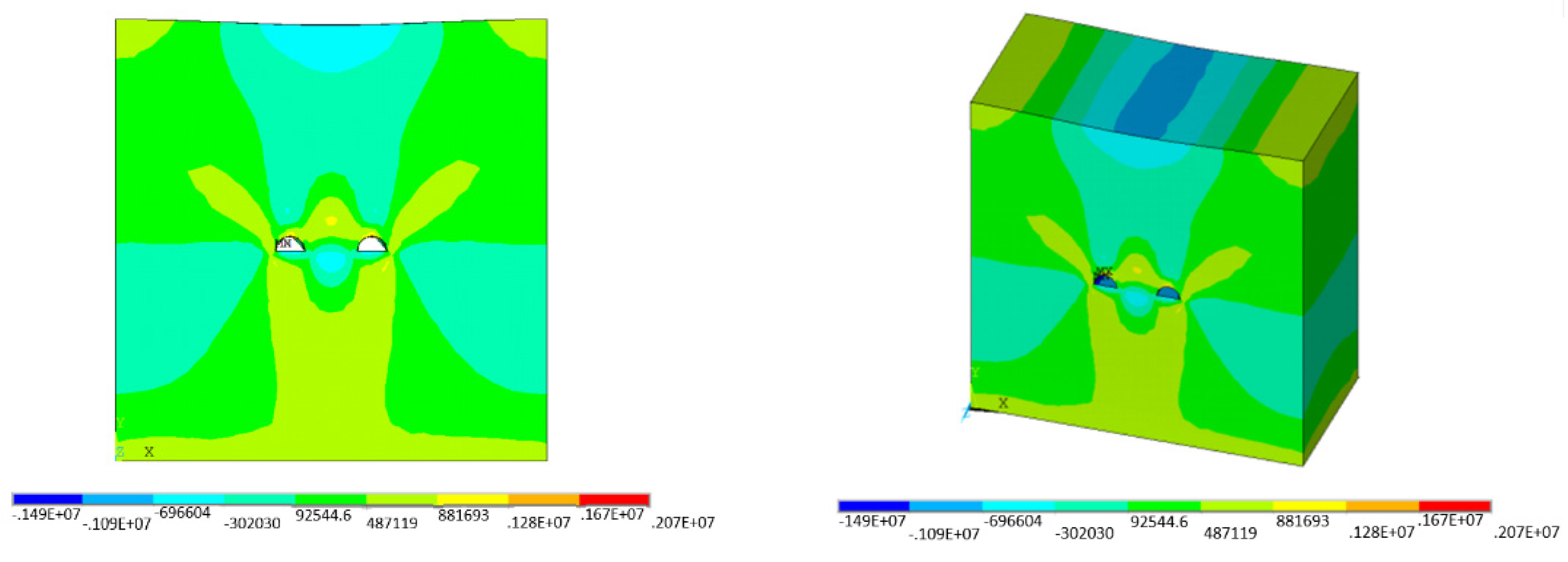
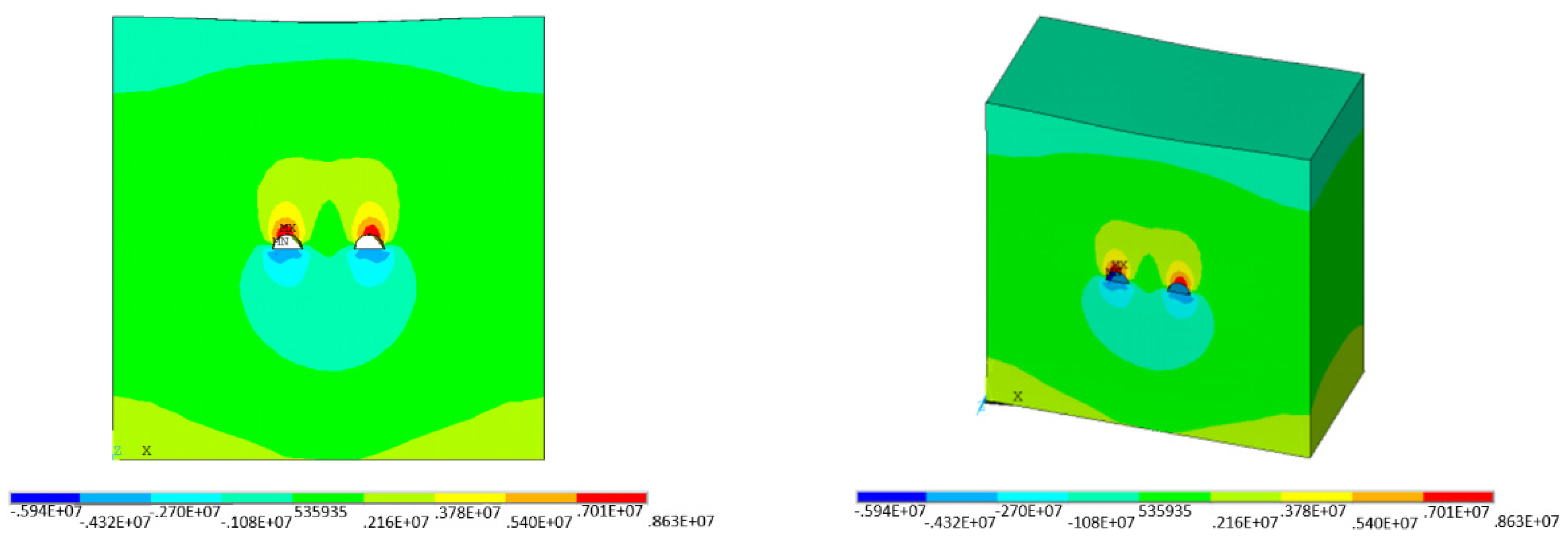

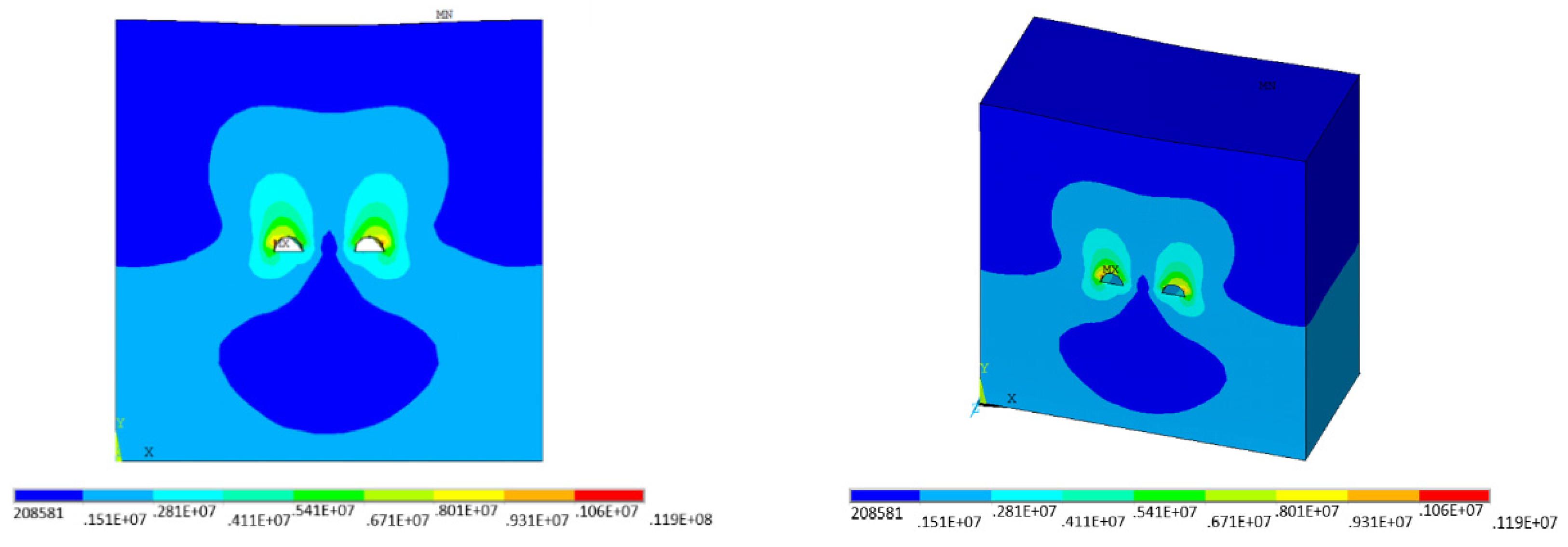
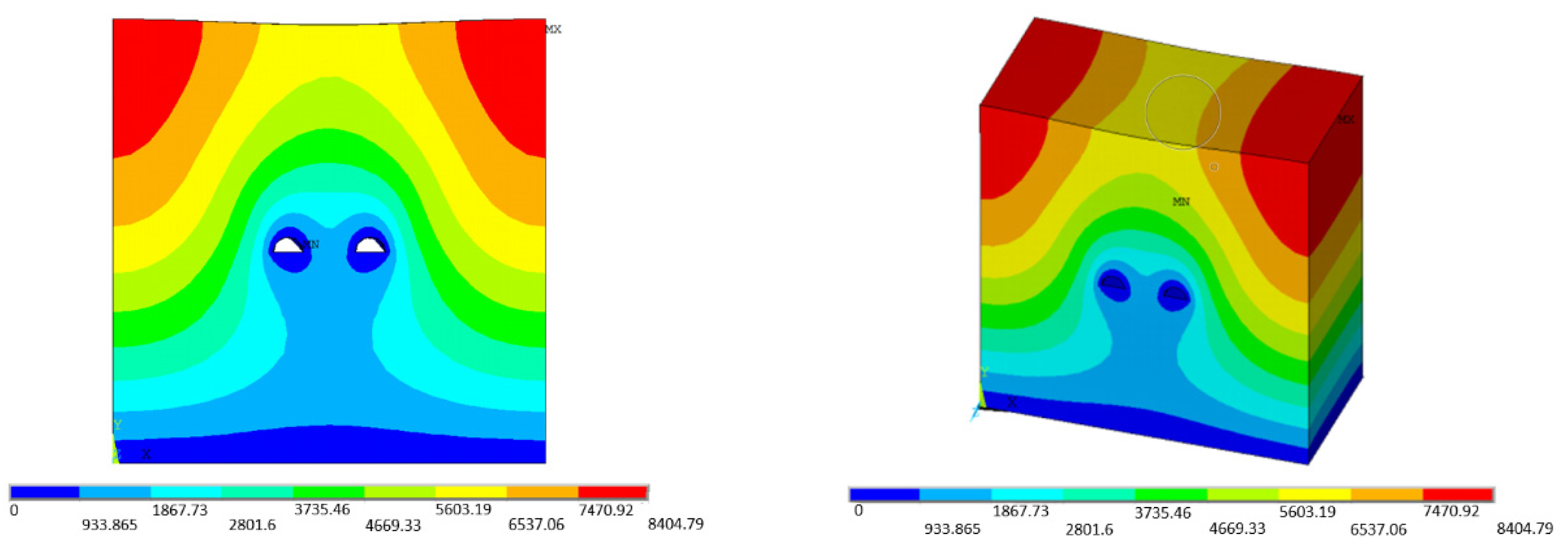
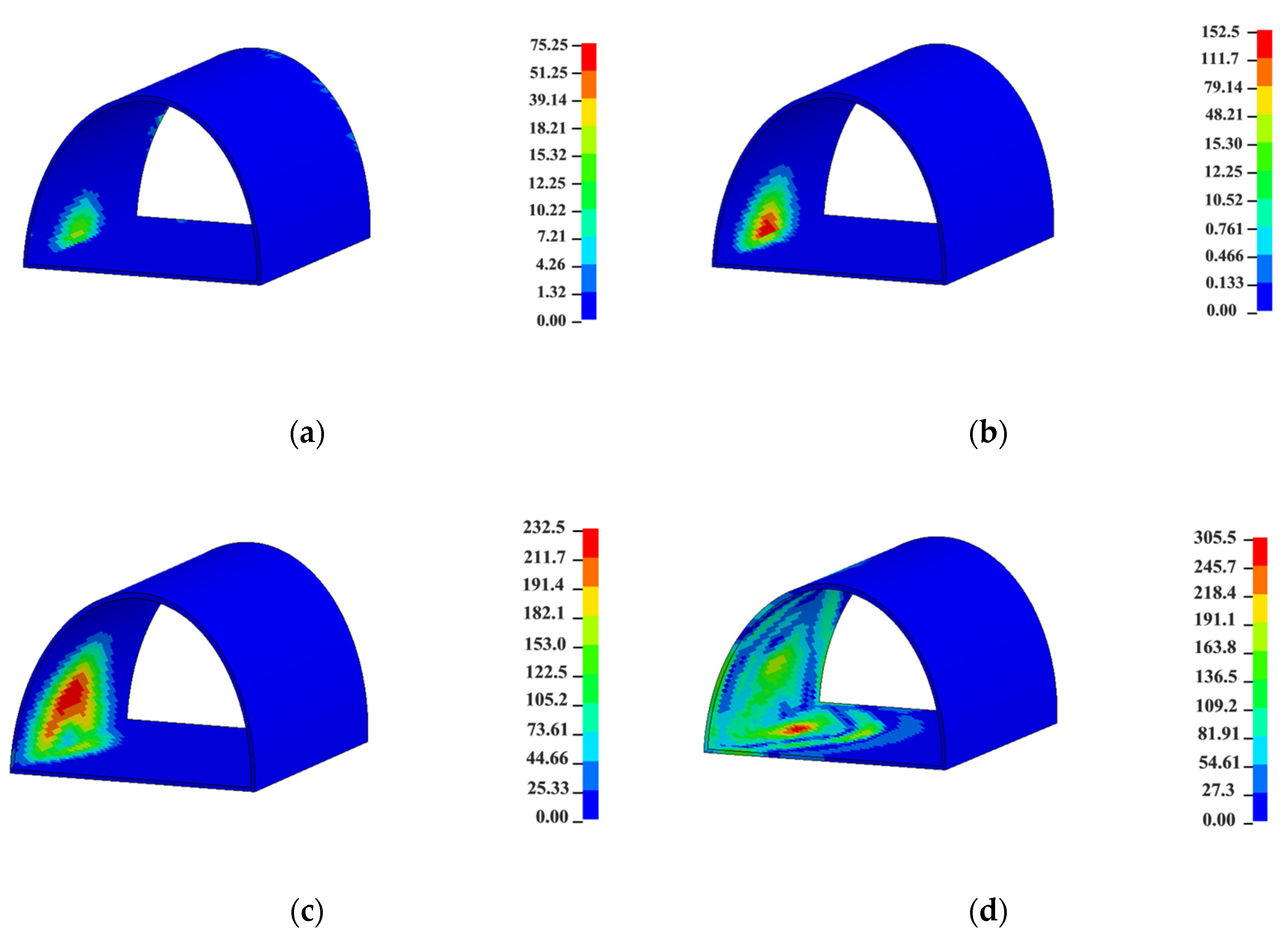
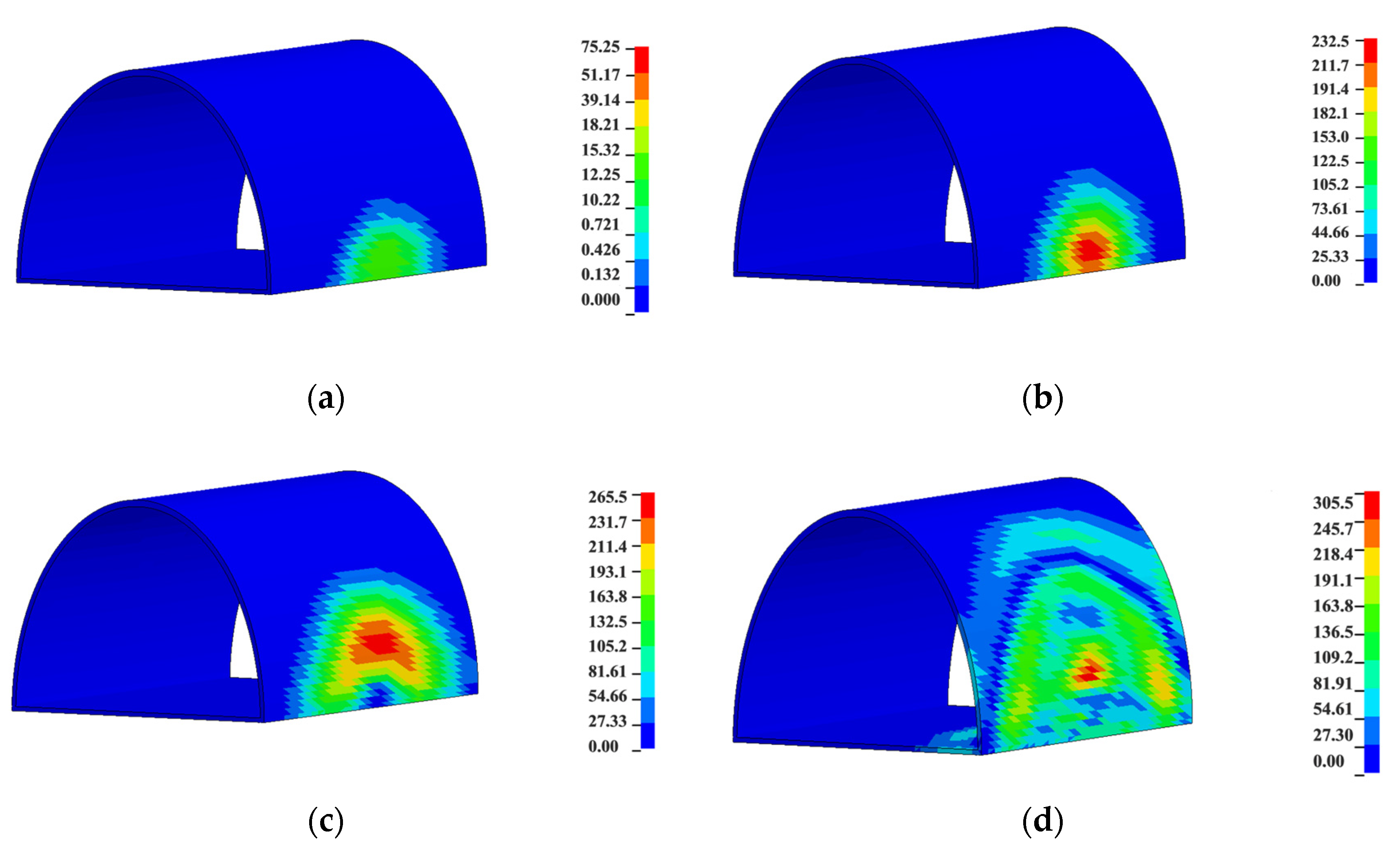
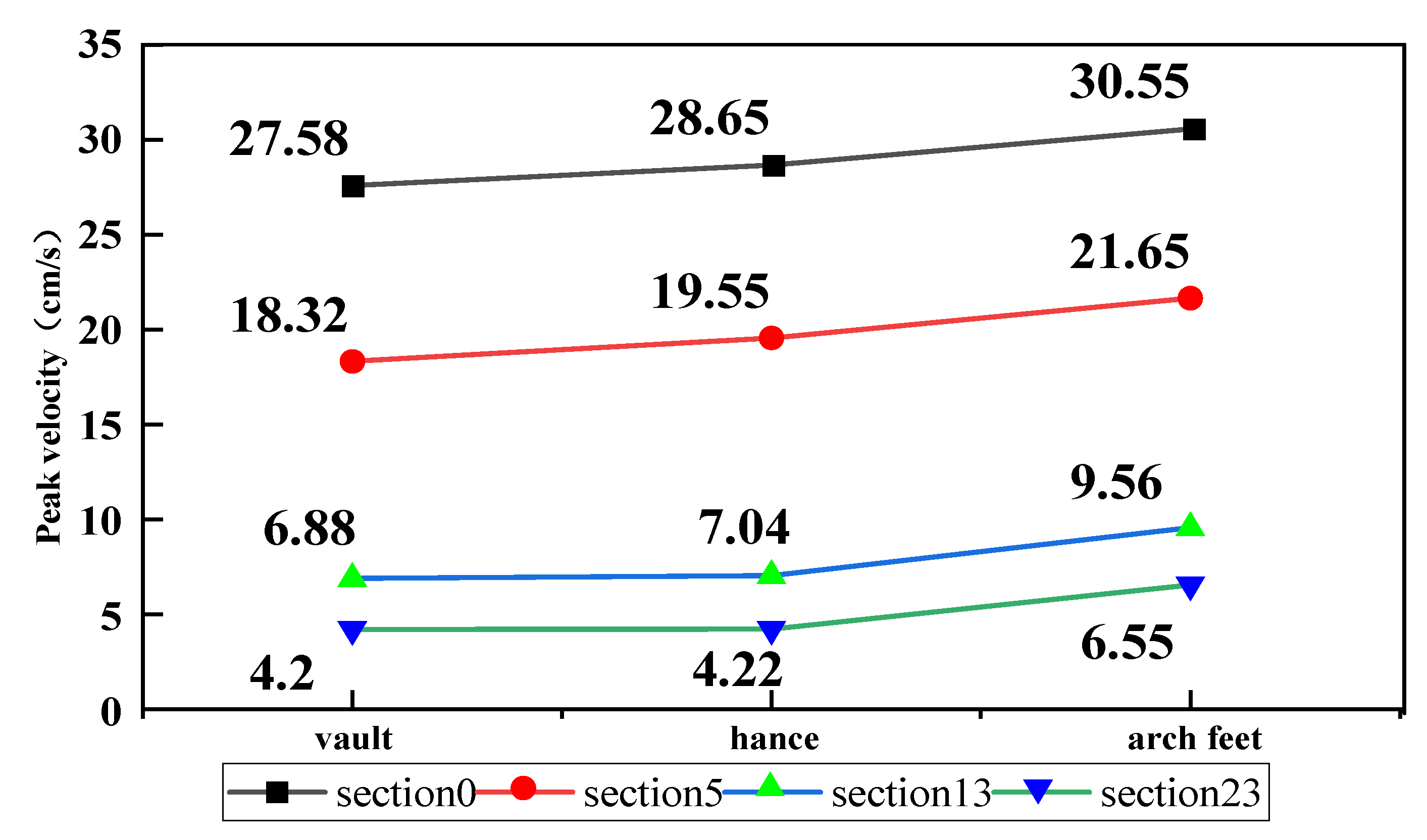
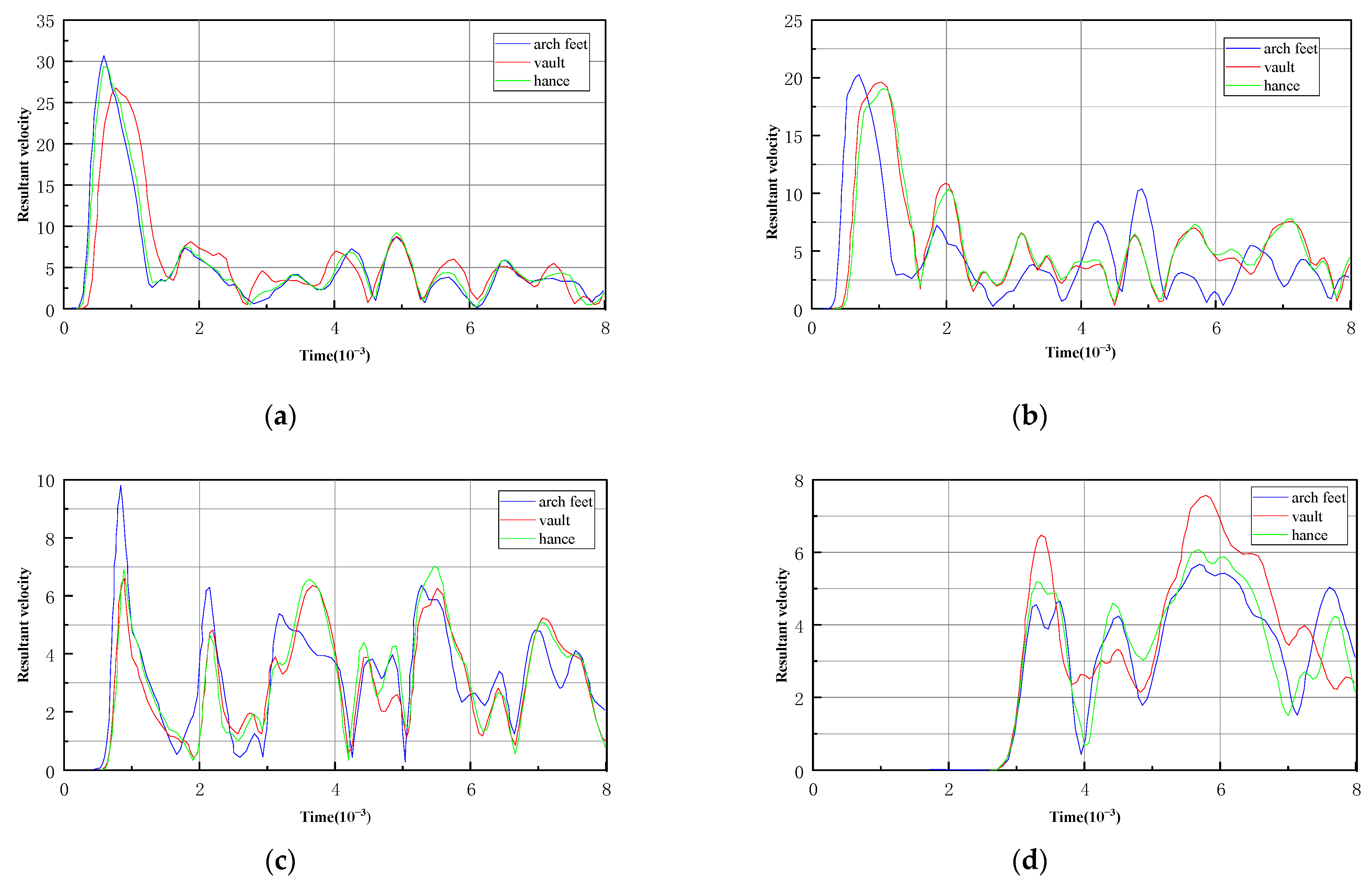
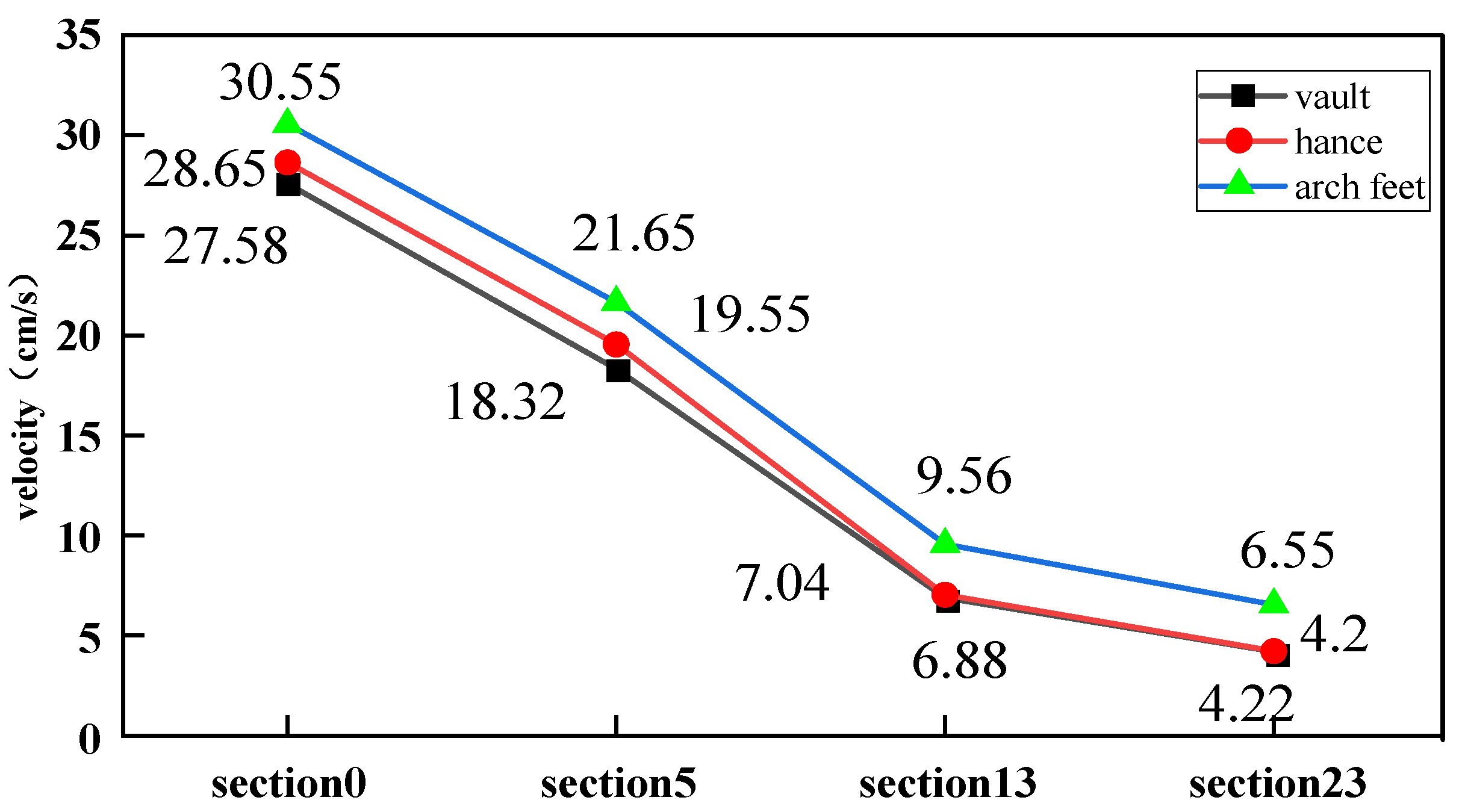


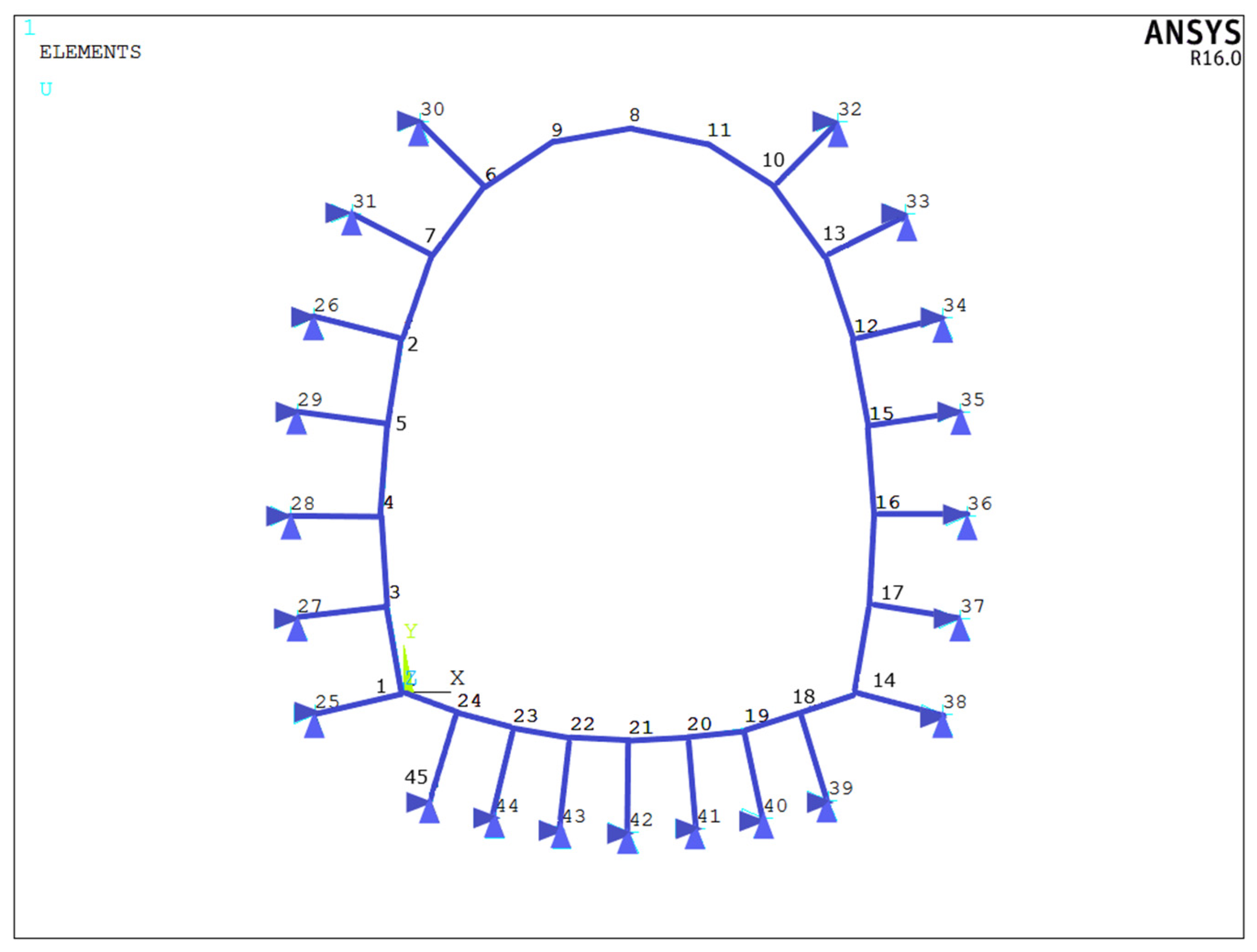



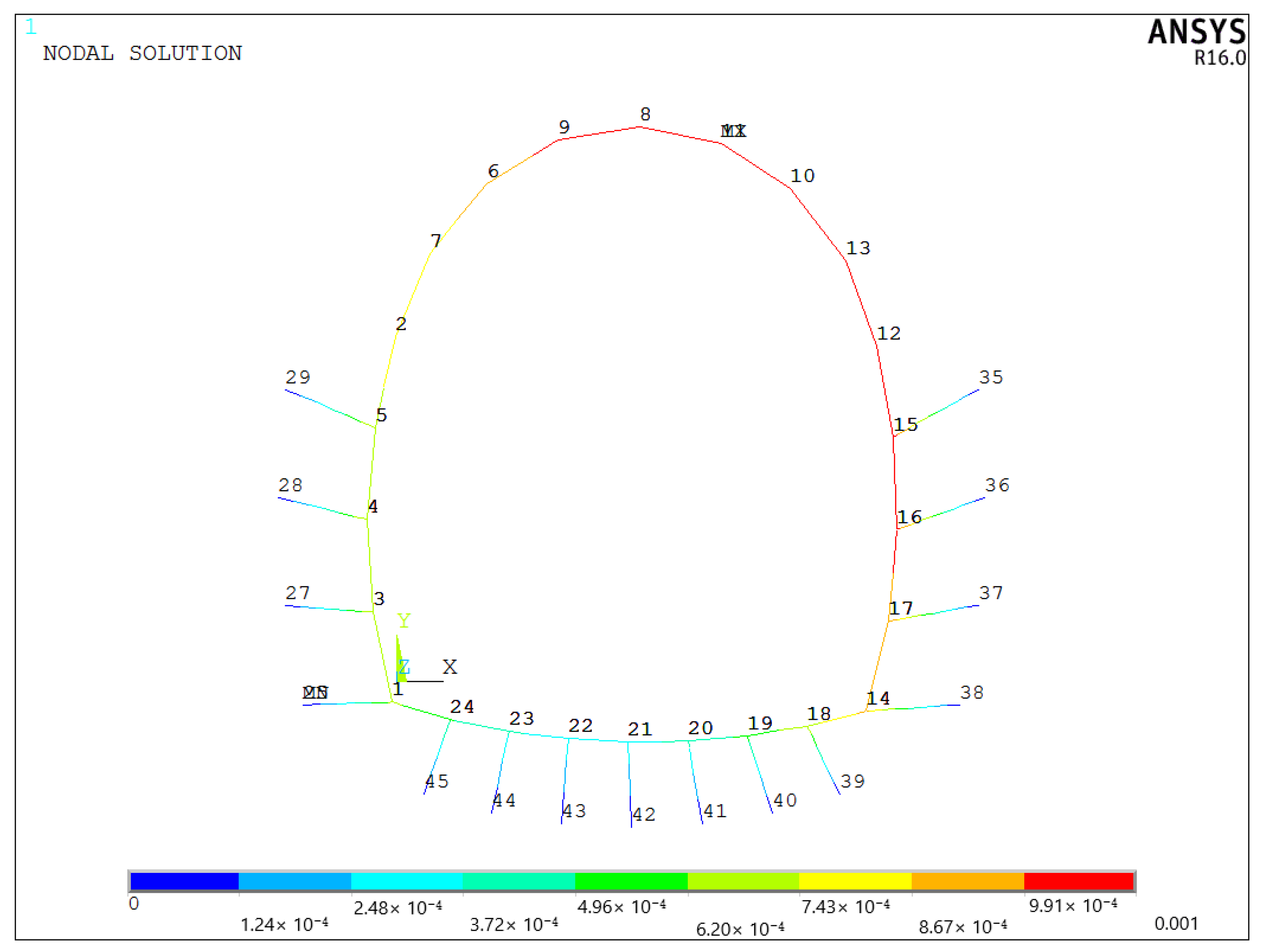
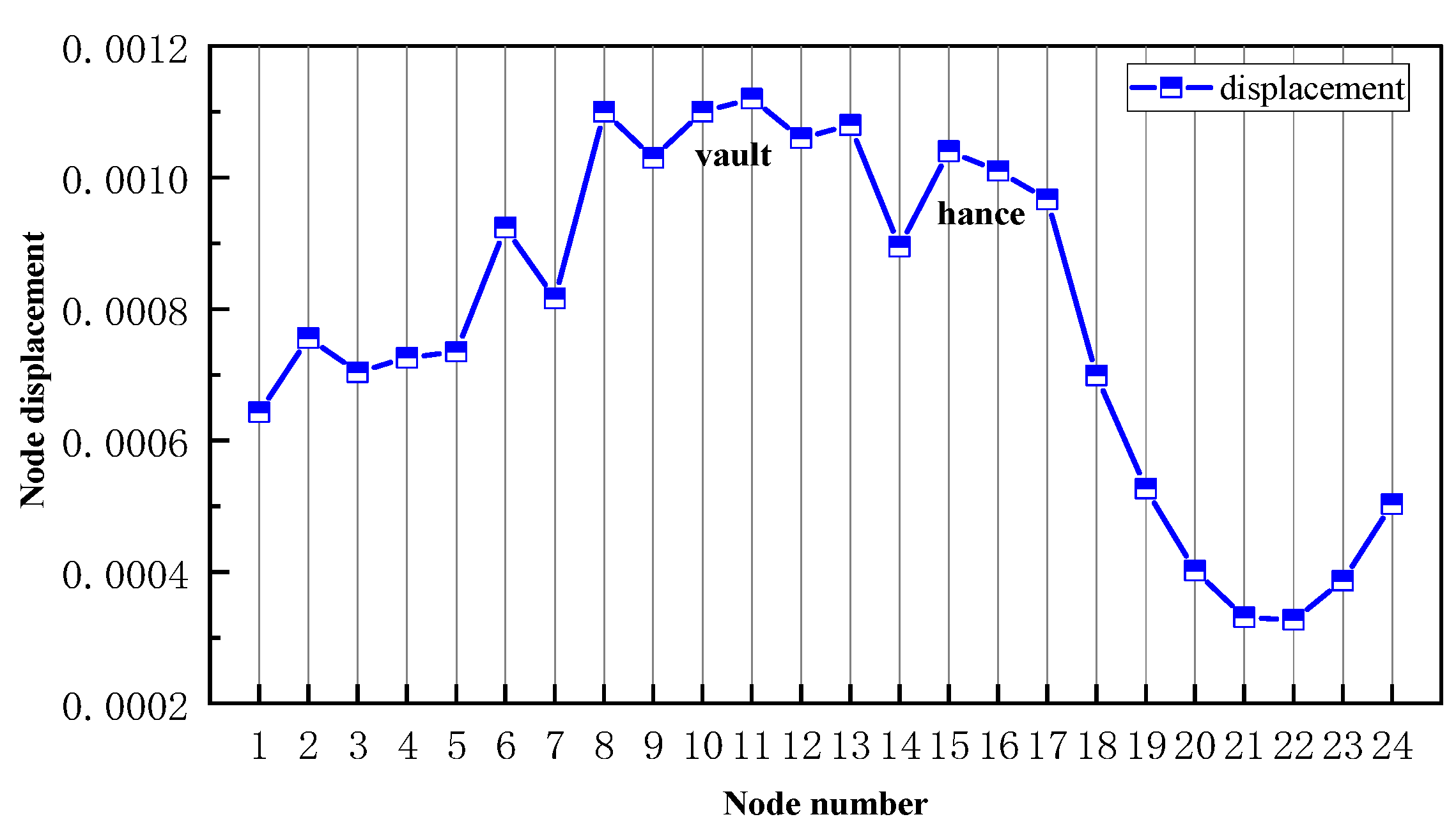
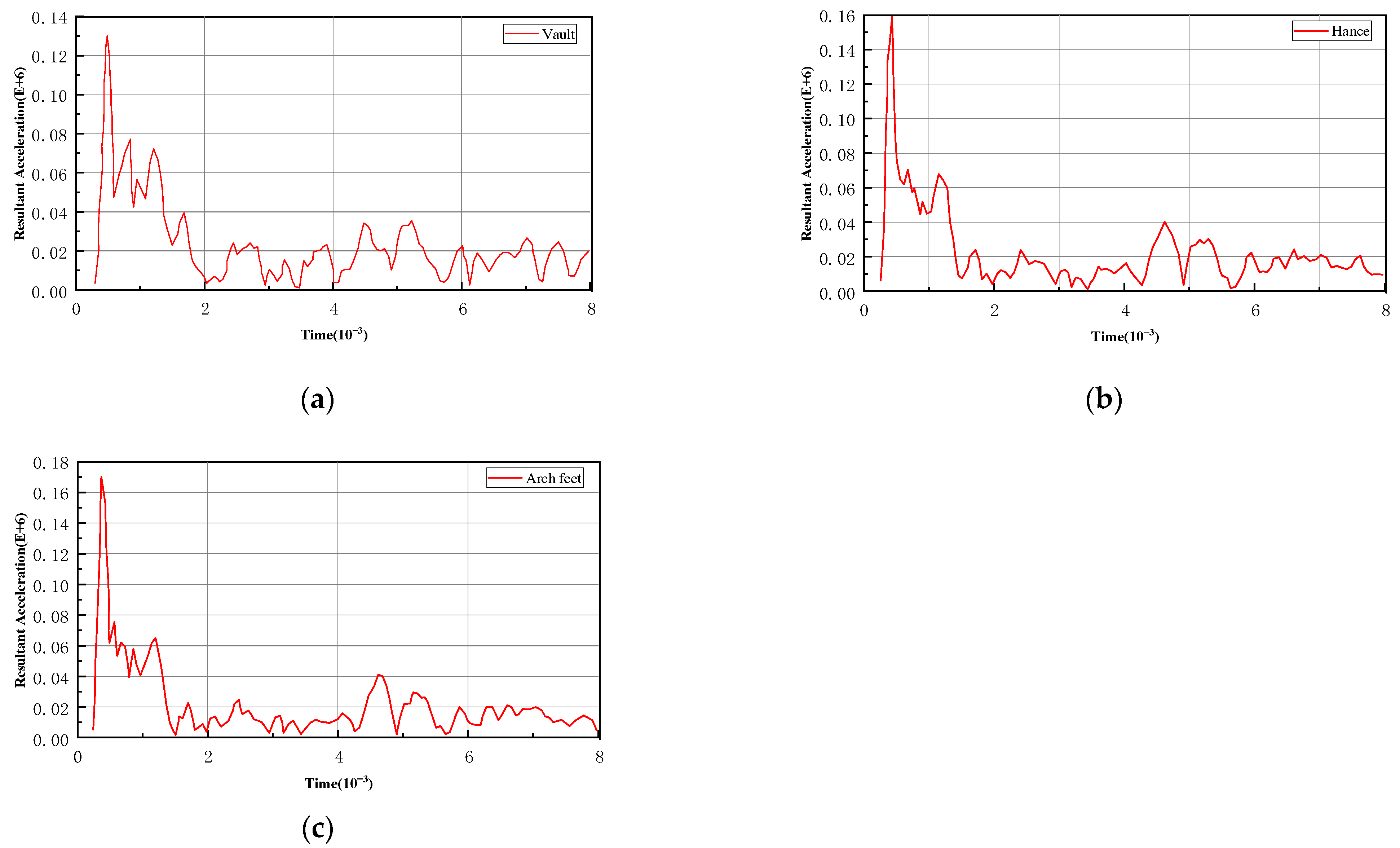
| Number | Distance (m) | Vibration Velocity (cm/s) | |||
|---|---|---|---|---|---|
| Vx | Vy | Vz | Vr | ||
| 1 | −5 | 16.45 | 14.88 | 8.56 | 16.33 |
| 2 | 0 | 27.95 | 17.84 | 12.16 | 27.55 |
| 3 | 5 | 17.22 | 13.15 | 8.48 | 18.06 |
| 4 | 13 | 5.22 | 3.19 | 3.44 | 6.31 |
| 5 | 23 | 3.22 | 2.08 | 2.15 | 3.96 |
| 6 | 0 | 19.82 | 10.66 | 6.86 | 18.09 |
| 7 | 0 | 6.65 | 4.32 | 3.89 | 7.35 |
| Direction | a | b | K | α | R2 |
|---|---|---|---|---|---|
| X | 4.77 | 1.60 | 117.92 | 1.60 | 0.82 |
| Y | 4.61 | 1.73 | 100.48 | 1.73 | 0.78 |
| Z | 3.70 | 1.29 | 40.04 | 1.29 | 0.88 |
| Resultant | 4.62 | 1.44 | 101.49 | 1.44 | 0.84 |
| Formula of Vibration Velocity Attenuation | Correlation Coefficient |
|---|---|
| Direction | K | α | R2 |
|---|---|---|---|
| X | 161.55 | 1.85 | 0.89 |
| Y | 81.93 | 1.53 | 0.84 |
| Z | 44.48 | 1.36 | 0.78 |
| Resultant | 144.18 | 1.73 | 0. 85 |
| Formula of Vibration Velocity Attenuation | Correlation Coefficient |
|---|---|
(kg/m3) | e (GPa) | ν | (kN/m3) | c (MPa) | (MPa) | |
|---|---|---|---|---|---|---|
| 2400 | 13 | 0.275 | 24 | 1.1 | 1.12 | 44.5 |
(kg/m3) | e (GPa) | ν | |
|---|---|---|---|
| Invert (C20) | 2500 | 25.5 | 0.2 |
| Shotcrete (C30) | 2500 | 30.0 | 0.2 |
| Secondary lining (C35) | 2500 | 31.5 | 0.2 |
| Number | Numerical Calculation of Velocity (cm/s) | Measured Vibration Velocity (cm/s) | Percentage Error |
|---|---|---|---|
| 1 | 17.21 | 16.33 | 5.4% |
| 2 | 28.65 | 27.55 | 4.0% |
| 3 | 19.55 | 18.06 | 8.3% |
| 4 | 7.04 | 6.31 | 11.5% |
| 5 | 4.22 | 3.96 | 6.6% |
| 6 | 20.18 | 18.09 | 11.6% |
| 7 | 8.33 | 7.35 | 13.3% |
| Measuring Point | Peak Vibration Velocity of the Vault (cm/s) | Peak Vibration Velocity of the Hance (cm/s) | Peak Vibration Velocity of the Arch Foot (cm/s) |
|---|---|---|---|
| Section 0 | 27.58 | 28.65 | 30.55 |
| Section 5 | 18.32 | 19.55 | 21.65 |
| Section 13 | 6.88 | 7.04 | 9.56 |
| Section 23 | 4.20 | 4.22 | 6.55 |
Disclaimer/Publisher’s Note: The statements, opinions and data contained in all publications are solely those of the individual author(s) and contributor(s) and not of MDPI and/or the editor(s). MDPI and/or the editor(s) disclaim responsibility for any injury to people or property resulting from any ideas, methods, instructions or products referred to in the content. |
© 2023 by the authors. Licensee MDPI, Basel, Switzerland. This article is an open access article distributed under the terms and conditions of the Creative Commons Attribution (CC BY) license (https://creativecommons.org/licenses/by/4.0/).
Share and Cite
Shi, J.; Xu, W.; Zhang, H.; Ma, X.; An, H. Dynamic Response and Failure Mechanism of Deep-Buried Tunnel with Small Net Distance under Blasting Load. Buildings 2023, 13, 711. https://doi.org/10.3390/buildings13030711
Shi J, Xu W, Zhang H, Ma X, An H. Dynamic Response and Failure Mechanism of Deep-Buried Tunnel with Small Net Distance under Blasting Load. Buildings. 2023; 13(3):711. https://doi.org/10.3390/buildings13030711
Chicago/Turabian StyleShi, Jianjun, Wenxiang Xu, Hao Zhang, Xinyan Ma, and Huaming An. 2023. "Dynamic Response and Failure Mechanism of Deep-Buried Tunnel with Small Net Distance under Blasting Load" Buildings 13, no. 3: 711. https://doi.org/10.3390/buildings13030711






